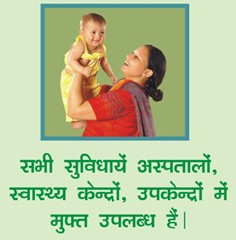 We normally assume that public health constantly improves, if only incrementally for long stretches. But then along comes a story like this, detailing how Delhi’s infant mortality rate has doubled since 2005. The obvious culprit is the continuing influx of rural migrants, few of whom seek professional medical care while pregnant—or, for that matter, for their deliveries.
We normally assume that public health constantly improves, if only incrementally for long stretches. But then along comes a story like this, detailing how Delhi’s infant mortality rate has doubled since 2005. The obvious culprit is the continuing influx of rural migrants, few of whom seek professional medical care while pregnant—or, for that matter, for their deliveries.
The Indian government’s challenge, then, is to convince poorer citizens that hospital deliveries won’t saddle them with massive debt, and that trained doctors are actually more competent than practitioners of folk medicine. For efficiency’s sake, these lessons need to be taught in provincial communities, before women jet for megacity slums where social services are more difficult to deliver.
There is a national plan in place to make this a reality: Janani Suraksha Yojana, which literally pays women to use hospitals. The program claims to have made payouts to over 159 million women since its inception three years ago. But as is often the case with massive bureaucracies, Janani Suraksha Yojana may not work as well as advertised. This tragic tale from Kolkata makes that all-too-clear:
When I met Namita Murmu in Mallickpur in Hooghly’s Dhanekhali block to enquire about the Janani Suraksha Yojana, she began to tell me the story of the death of her child. After it was born — a pale, frail-looking creature — the doctors at the block hospital had informed Namita that she was entitled to a sum of Rs 500 for six months before and after childbirth under the JSY. Namita qualifies for the provisions of the JSY because she is the holder of a valid BPL card. Namita had carefully followed the procedure to avail herself of the benefits of this scheme. She had informed the block development office, filled the application form and was told that her name had been included in the list of beneficiaries. Yet, the money had not reached her, and one morning, she found her sickly child lying cold and still. She still believes that the money could have saved her child’s life. Namita is now a mother again, but she still does not know why she did not receive her dues.
As is so often the case with ambitious schemes that rely too heavily on human competence, the devil is in the details.


Bobby // Jul 6, 2009 at 11:51 am
Good grab, Brendan, but it’s not just the scientific illiteracy of rural migrants in India that can cause public-health problems. As I’m sure you’re aware, YBMSS (yuppie-borne-medical-scorn-syndrome) is turning out to be a particularly threatening problem here at home:
Despite overwhelming evidence that vaccines don’t cause autism, one in four Americans still think they do. Not surprisingly, the first half of 2008 saw the largest US outbreak of measles—one of the first infectious diseases to reappear after vaccination rates drop—since 2000, when the native disease was declared eliminated (see Figure 2). Mumps and whooping cough (pertussis) have also made a comeback. Last year in Minnesota, five children contracted Hib, the most common cause of meningitis in young children before the vaccine was developed in 1993. Three of the children, including a 7-month-old who died, hadn’t received Hib vaccines because their parents either refused or delayed vaccination.
The article goes on to report similar effects in Great Britain. When will the government step in to save us from Jenny McCarthy?
Brendan I. Koerner // Jul 6, 2009 at 12:08 pm
@Bobby: Excellent point. My wife and I actually had the vaccine debate after our son was born. I was somewhat aghast at her suspicions, seeing as how I knew they were totally unsubstantiated by any scientific evidence. But rumor is oh-so-powerful…
Microkhan is firmly committed to the war against illogic. So we’ll keep an eye peeled for new stories that drive home your valuable point.